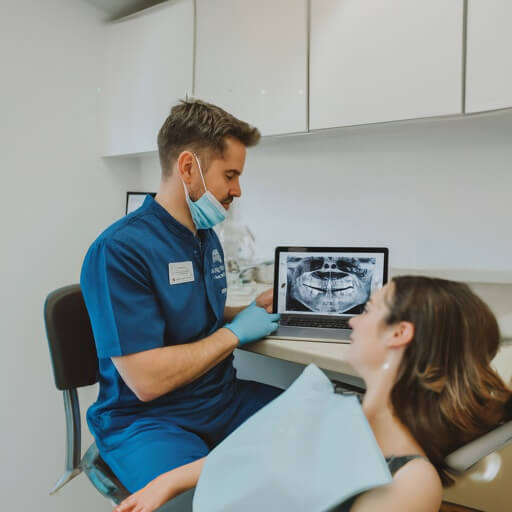Although crowns offer substantial durability and protection, the underlying tooth remains susceptible to cavities and decay. Decay under a crown can cause various oral health problems, including sore gums, bad breath, infection, and potentially tooth loss or the need for extraction.
Let’s explore a recent example that we encountered in our practice.
How Did My Crown Decay?
The short answer is that it did not decay, but let’s find out how we got to that question.
I saw this woman this week, and she required some care for a tooth with a crown. When I saw her at a checkup, our x-rays revealed a problem with the tooth.
She confirmed that she feels discomfort in her tooth when she eats, reinforcing our findings. Sometimes, we see things, and the patient has no idea of any problems. That is a true statement most of the time. In our case, her pain backed up what we saw.
Signs and Symptoms
In medicine, what can be observed either with the naked eye or through some imaging is called a sign.
What the patient feels or experiences is called a symptom. Her discomfort when eating is called a symptom, and she was anxious to get her problem solved. She avoided eating on the left side of her mouth, and thus, eating became a real chore as she had to be conscious of how her teeth met and where the food was in her mouth. In a health situation, we chew, and the food goes where it needs to go.
Do Crowns Decay?
I told her that we needed a follow-up visit to address her issue and that she had decay under a crown. I did not think twice about that remark, but she certainly did.
When she returned to me, she wondered how a crown could decay. I thought about her question and explained to her that her thoughts were correct.
Decay applies to some organic or living material.
The term refers to the slow breakdown of living matter with a loss of structure and integrity.
We have all seen a rotting piece of wood or even a tree. These are examples of decay.
A crown is not made of living material, although it does replace a part of a tooth that is part of a living organism. A crown covers a tooth that has had some breakdown, such as decay or fracture of tooth material.
Traditionally, crowns were made of some metal, with gold being one of the most famous. Gold has many properties that are kind to the structures in the mouth. As time passed and the esthetic and cosmetic revolution took hold of dentistry, we looked for other materials to mimic tooth structure and color. Porcelain and other ceramics were called into play to fill this role.
Please note that all the materials we have used and currently use are not living tissue and, therefore, can not decay.
This begs the question, what do we mean when we see decay on a crown?
The Decay Under The Crown is The Culprit
The answer lies in how much of the tooth extends beyond the edge of the crown as we look towards the gum.
Any exposed tooth structure has the potential to decay and rot away. If this exposed tooth or root is between the teeth, you will never see that area with your naked eye. Only discomfort or an x-ray will reveal the problem. She developed decay along the tooth’s root, which progressed and burrowed its way below the edge of the crown to the center of the tooth, resulting in discomfort.
So, the crown did not decay. The tooth under or inside the crown, if you will, was the area of the breakdown.
The Importance of Early Detection
This case highlights the importance of early detection of dental problems, as it can prevent such discomfort and inconvenience.
Teeth with crowns should be checked regularly and evaluated for breakdown.
If you have crowns in your mouth, don’t miss your regular checkup and cleaning. Call us at 440.951.7856 to schedule that visit, and I look forward to meeting you.
Jeffrey Gross, DDS, FAGD is an Ohio licensed general dentist and is on the staff of Case Western Reserve School of Dental Medicine.

